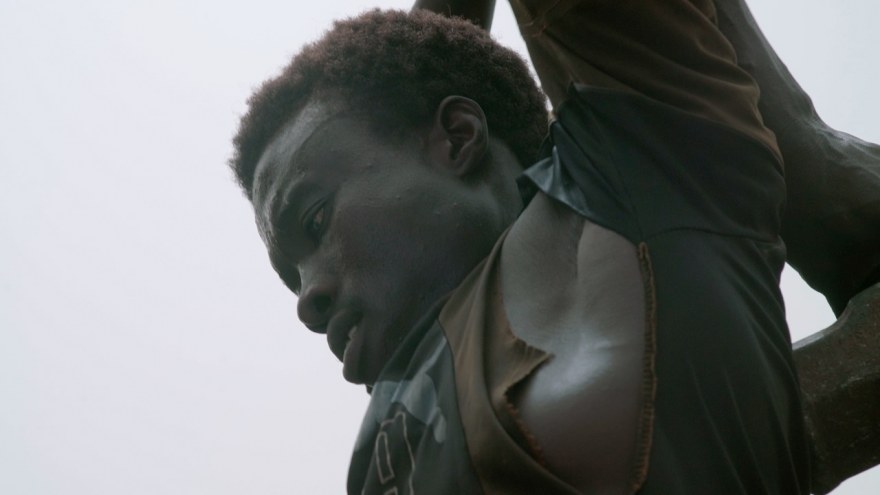Night cap with Carrière de Pissy
Interview with Eliott Chabanis, director of Carrière de Pissy
How did you find out about the quarry in Pissy?
A great deal of luck. Carrière de Pissy is a student film that I made through the Ciné Nomad School: an international exchange project among several film schools (in Burkina Faso, Benin, Nigeria, Poland and France). The idea of the project was to make a film abroad with a crew made up of students from all of the countries except the host country. My project was to make a film without really knowing what we were going to do. The goal was to break with the “standard” model in order to avoid reproducing what we already know how to do, and instead to find other ways of creating in the hopes of expressing something new. A project where we had no expectations and tried out things with no pretense. All the same, I did give us a direction, a topic, namely fighting for something. What does “fighting” mean nowadays? How do we fight for something? How do we make ourselves heard? When we landed, I met Malik Borro, the production designer from Burkina Faso who was great to work with! We talked a lot about the topic and he took me to visit several places where the fight is carried on in different ways. Until we ended up at the quarry. When I saw it, I was suddenly awakened. I saw how our economic system imprisons the most destitute people. It was no obvious matter facing up to some of the realities of the place.
Did you do research on the financial and family situations of the prospectors we see in the film?
They’re stone breakers, they extract granite from the rock to turn them into stones which are the raw material for the country’s roads. I was in Burkina Faso for a month, preparing on my own for two weeks when I was able to meet some of the workers, and two weeks filming with the crew. I opted to make a film based on my feeling about the work, the place and the people rather than on a direct explanation of the situation, which seemed too unequivocal.
Do you know about how long the oldest stone breaker in the quarry had been working there?
I don’t have the exact date, but the quarry has been there since colonial times. It was run by the French.
Why did you not want the voices in the film to be distinct or intelligible?
Because words tell very little in films. I was trying to making a film where the expression came from a sense, not from the intellect. For me, images and sound in movement have a real sensory potential which strikes me as one of cinema’s peculiarities and strong points. Words touch another mode of expression which is more of a code / decoding, reflection, something you need to understand and which often takes up too much space. Here, it’s more the workers’ gestures that make up the film’s expression. Taking a step back, I just don’t feel comfortable enough with words for them to add depth of expression to the film.
How long did it take you to compose the score from original material? What were you aiming for?
I like to imagine the sound for what it tells on its own, without it being dependent upon the images or synching. I always try to make sure the sound doesn’t repeat what the images already express, and vice versa. We spent a week on the sound editing and another on the mixing. I didn’t necessarily have ideas for all the scenes, so Marilou, the sound editor, and Tom, the mixer, made numerous suggestions until we got it how we liked it.
What interested you about the female character? Did you meet her at the quarry or did you bring her with you?
Madeleine’s presence at the site really spoke to me. I met her at the quarry just like all the other characters in the film though I didn’t meet them at the same time. During my two weeks of preparation, I went to the quarry every day to meet the workers. Very quickly, I realized that it would be difficult to get close them in any genuine way in two weeks, given the economic, cultural, linguistic gulf and the gulf in comfort level that separated us. “Whites” are immediately viewed as “bosses”. That perception is hard to break down especially when you’re conscious that your camera represents four years of wages in the quarry. That made me waver psychologically – no one confronted me, it was like I could do what I wanted and their images were of no importance. I had a lot of responsibilities on my shoulders. I tried as best I could to respect that distance and to be as honest about our relations in the film. In the end, I think the distance is also a form of proximity.
Have you discovered any advantages that the short film form offers?
The freedom to screw up. There’s a lot less pressure with less money at stake and without the obligation of having to be profitable. Which is an even greater freedom when you’re a student, especially a student at CinéFabrique.
Which films did you draw from?
There are a lot, but not necessarily a particular list for this film. In general, I like films that use the cinematic medium in new ways. I think before I left, the last films that I’d really liked were Bogdan Dziworski’s Dwubój klasyczny [Nordic Combination] and Pascal Aubier’s Le dormeur [The Sleeper]. However, after I’d finished the film, I discovered The House is Black by the incredible Iranian poet Forugh Farrokhzad. The House is Black is about a leper colony in Tabriz where Farrokhzad redefines our view of ugliness. She begins the film with these words: “There is no shortage of ugliness in the world. If man closed his eyes to it, there would be even more… On this screen will appear an image of ugliness, a vision of pain no caring human being should ignore. To wipe out this ugliness and to relieve the victims is the motive of this film and the hope of its makers.” I very much identify with that intention.
Carrière de Pissy is part of Lab Competition L2.








